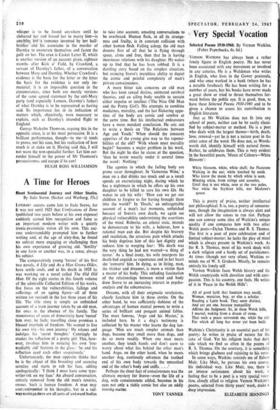Death in Edinburgh
THE crime, of course, is the death of Darnley and thus in the title itself the author's solution of the mystery is announced. For Kirk o' Field remains a mystery. Did the explosion which awakened Edinburgh in a night four centuries ago—February 10, 1567—betoken that Mary Queen of Scots was an accomplice of her lover, Bothwell, in the murder of her husband? Or was it Darnley who had engineered to dispose of Mary and was very much hoist with his own petard? The former is the legend, almost inde- structible, perpetuated romantically through the centuries. The latter is probably the truth.
Mr Thomson's book, coming down firmly on the side of the legend, is (whatever one's own predilections) one of the best of the numerous books on Mary. One does not know which to admire most, the thoroughness of his knowledge, the felicity with which he handles his complex material to simplify without distortion or—even when one most violently disagrees with him— the adeptness of his-advocacy.
In the last analysis, the case against Mary depends solely on the Casket Letters. At the very least, these could never be accepted as evi- dence in a modern court of law, even if they are not dismissed out of hand as forgeries. No one, from the time of their 'discovery' till today, has certainly seen the originals and Mary and her Commissioners were not allowed even to have copies of them. The letters shown to the English Commissioners were in Scots; there were then 'translations' of them into English, Latin and French, though the only complete set were in Scots. The French versions of some of them which Cecil kept in his private archives in Hat- field differ from the published French versions of 1573. There is no trace anywhere of any of the 'originals' which Mary asked so per- sistently and fruitlessly to be allowed to see.
In short, there is no evidence that the accepted story of Mary's love for Bothwell—of which no whisper is to be found anywhere until he abducted her and forced her to marry him—is anythrtig bid :a romance invented by her half- brother and his associates in the murder of Darnley to exonerate themselves and fasten the guilt on her. The crux is Casket Letter II, which is another version of an account given, eighteen months after Kirk o' Field, by Crawford, a servant of Darnley's father, of a conversation between Mary and Darnley. Whether Crawford's evidence is the basis for the letter or the letter the basis for the evidence is not only im- material; it is an impossible question in the circumstances, since both are merely versions of the same agreed statement by the anti-Mary party (and especially Lennox, Darnley's father) of what Darnley is to be represented as having said. Its importance lies in its indication of matters which, objectively, were necessary to explain, such as Darnley's intended flight to England.
George Malcolm Thomson, arguing this in the opposite sense, is at his most persuasive. It is a brilliant performance, though—to me—it tends to prove, not his case, but his realisation of how much is at stake on it. Having said this, I will not warn the non-specialist further. Let him sur- render himself to the power of Mr. Thomson's persuasiveness and escape if he can!
HUGH ROSS WILLIAMSON































 Previous page
Previous page